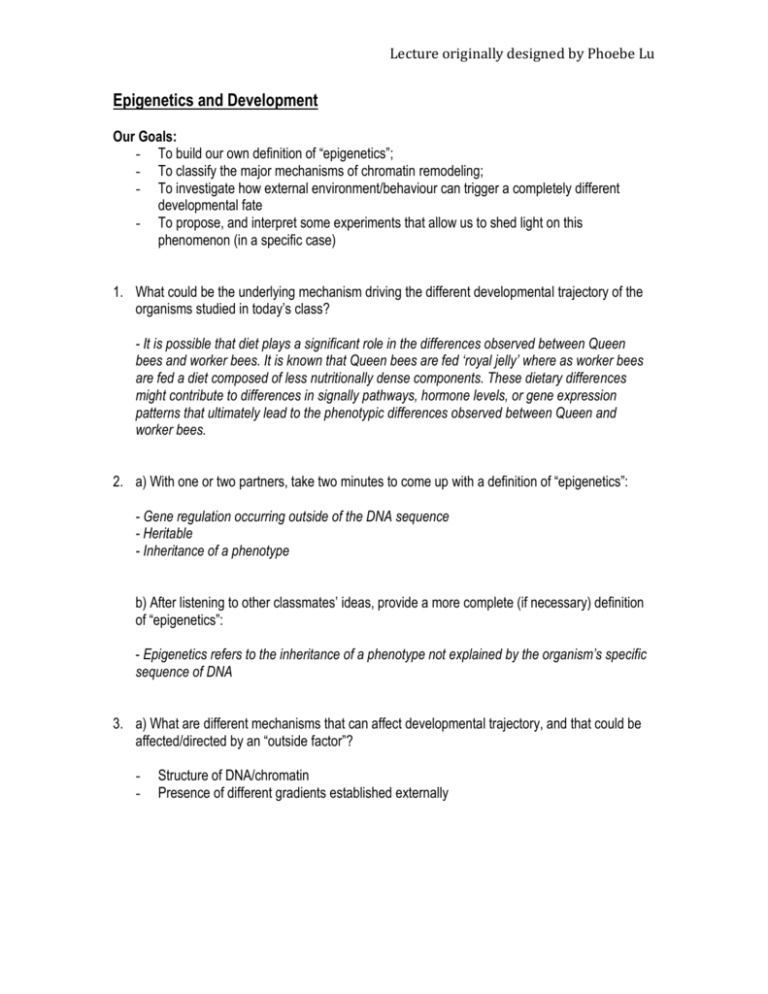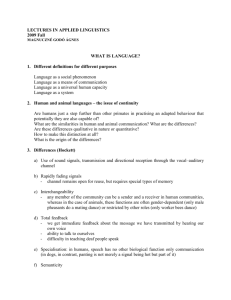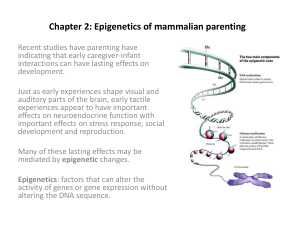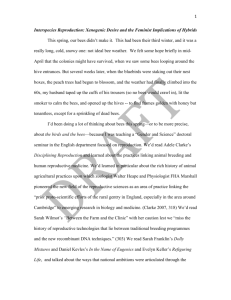In-Class Assignment – March 30th
advertisement

Lecture originally designed by Phoebe Lu Epigenetics and Development Our Goals: - To build our own definition of “epigenetics”; - To classify the major mechanisms of chromatin remodeling; - To investigate how external environment/behaviour can trigger a completely different developmental fate - To propose, and interpret some experiments that allow us to shed light on this phenomenon (in a specific case) 1. What could be the underlying mechanism driving the different developmental trajectory of the organisms studied in today’s class? - It is possible that diet plays a significant role in the differences observed between Queen bees and worker bees. It is known that Queen bees are fed ‘royal jelly’ where as worker bees are fed a diet composed of less nutritionally dense components. These dietary differences might contribute to differences in signally pathways, hormone levels, or gene expression patterns that ultimately lead to the phenotypic differences observed between Queen and worker bees. 2. a) With one or two partners, take two minutes to come up with a definition of “epigenetics”: - Gene regulation occurring outside of the DNA sequence - Heritable - Inheritance of a phenotype b) After listening to other classmates’ ideas, provide a more complete (if necessary) definition of “epigenetics”: - Epigenetics refers to the inheritance of a phenotype not explained by the organism’s specific sequence of DNA 3. a) What are different mechanisms that can affect developmental trajectory, and that could be affected/directed by an “outside factor”? - Structure of DNA/chromatin Presence of different gradients established externally Lecture originally designed by Phoebe Lu b) What are the mechanisms that can affect chromatin structure? - Coiling & Supercoiling Acetylation/ Methylation Histone Modifications Methylases Factors involved with mitosis Chromatin remodeling structures: differences between nucleosomes 4. What would you predict about gene expression patterns in the two distinct developmental trajectories if epigenetics is driving the phenotype? - Differential expression of growth genes Differential expression of reproductive genes Pheromone expression differences Differences in overall energy distribution 5. Researchers (Grozinger et al., 2007) actually checked… what do you notice about the gene expression patterns in individuals following each of the two developmental trajectories? - This study showed an upregulation of genes associated with foraging behavior in worker bees Further, an upregulation of genes associated with reproducation and longevity was found in Queen bees 6. What kind of protein/factor could be a key component of the epigenetic control of developmental trajectories? How would you test your hypothesis? - As seen above, differential gene expression patterns lead to the differential phenotypes observed between Queen bees and Worker bees We know that a dietary difference is associated with whether a bee becomes Queen or a worker It is therefore likely that a protein/substance contained in royal jelly alters the global gene expression patterns in bees Knowing DNA methylation patterns and chromatin structure are large players in epigenetic differences, perhaps a protein altering DNA methylation patterns is present in royal jelly You could test this hypothesis by isolating removing proteins associated with DNA methylation from royal jelly and see if the removal of such factors are sufficient to prevent bees from becoming phenotypically ‘Queen.’ (This assumes known DNA methylation associated proteins are found in royal jelly) Lecture originally designed by Phoebe Lu 7. What did Kucharski and colleagues find, and what does their experiment suggest? - Kucharski found that bee larvae injected with Dnmt3 siRNA, to create Dnmt3 knockdowns, were found much more likely to develop into Queen-like bees. This suggests that wild type Queen bees have lower Dnmt3 expression Further, this suggests that a property of royal jelly might directly/indirectly alter Dnmt3 expression 8. a) What component of the food in question is most likely to affect gene regulation? - Since none of the major royal jelly proteins seem associated with methylation, perhaps it is a lipid found in royal jelly that affects Dnmt3 expression? b) How does the food in question activate a transcriptionally silenced gene? - A study by Spannhoff et al (2011), showed that the active component of royal jelly is 10HDA, a lipid. Further, studies exposing cells to just 10HDA was sufficient in activating a previously transcriptionally inactive gene, Fas. This showed that 10HDA is capable of activating gene expression, perhaps leading to the inactivation of Dnmt3.










